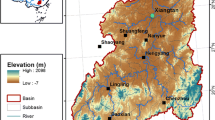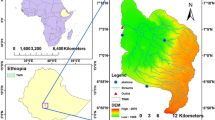Abstract
Identifying the trends of climate and hydrological changes is important for developing adaptive strategies for effective water resources management. Many studies focused on the prediction of future climate at a regional/global scale using General Circulation Models (GCM) or these models’ downscaled outcomes. However, diagnosing historical trends is regarded valuable for local areas, especially considering the spatial heterogeneity (both occurrence and magnitude) of climate change and uncertainty of climate projection. In this study, we selected the headwater area of the East River Basin in South China, which has minimal human-induced disturbance, to detect climate change and its hydrological changes over a past 50-year (1955–2004) time period. Although the climate warming agreed with the global situation, its magnitude was small and no sign of intensified rainfall or change of annual rainfall was found. Nevertheless, no-rain days increased and light-rain days decreased, indicating a longer dry interval between rainfall events. There was a significant downtrend of wind speed with a substantial reduction in magnitude, resulting in a decrease in the estimated potential evapotranspiration and a slight increase in the soil water content. Risks of flooding may not be a big concern, but water availability may be affected marginally in May and June due to the decreased rainfall and increased no-rain days. Overall, our results can improve the understanding of climate change and help watershed managers take precautions when facing climate change. This study also implies the necessity of investigating climate change at a local scale and at different time scales.





Similar content being viewed by others
References
Allen MR, Ingram WJ (2002) Constraints on future changes in climate and the hydrologic cycle. Nature 419:224–232
Arnold JG, Allen PM (1999) Automated methods for estimating baseflow and ground water recharge from streamflow records. J Am Water Resour Assoc 35:411–424
Arnold JG, Srinivasan R, Muttiah RS, Williams JR (1998) Large area hydrologic modeling and assessment - Part 1: Model development. J Am Water Resour Assoc 34:73–89
Beven KJ (2001) Rainfall-runoff modelling. John Wiley & Sons, Chichester, 360 pp
Cui W, Chen J, Wu YP, Wu YD (2007) An overview of water resources management of the Pearl River. Water Sci Technol Water Supply 7:101–113
Dono G, Cortignani R, Doro L, Giraldo L, Ledda L, Pasqui M et al (2013) An Integrated Assessment of the Impacts of Changing Climate Variability on Agricultural Productivity and Profitability in an Irrigated Mediterranean Catchment. Water Resour Manag 27:3607–3622
Green CH, van Griensven A (2008) Autocalibration in hydrologic modeling: Using SWAT2005 in small-scale watersheds. Environ Model Softw 23:422–434
Guo H, Xu M, Hu Q (2011) Changes in near-surface wind speed in China: 1969–2005. Int J Climatol 31:349–358
Houghton JT, Ding Y, Griggs DJ, Noguer M, Linden PJvd, Dai X, et al., 2001. Climate Change 2001: The Scientific Basis. Cambridge University Press, Cambridge, United Kingdom and New York, NY, USA
Hulme M, Osborn TJ, Johns TC (1998) Precipitation sensitivity to global warming: Comparison of observations with HadCM2 simulations. Geophys Res Lett 25:3379–3382
IPCC, 2013. Climate Change 2013: The physical Science Basis. Contribution of Working Group I to the Fifth Assessment Report of the Intergovernmental Panel on Climate Change, pp. 1535. Cambridge University Press, Cambridge, United Kingdom and New York, NY, USA.
Jung IW, Chang H, Risley J (2013) Effects of runoff sensitivity and catchment characteristics on regional actual evapotranspiration trends in the conterminous US. Environ Res Lett 8
Moriasi DN, Arnold JG, Van Liew MW, Bingner RL, Harmel RD, Veith TL (2007) Model evaluation guidelines for systematic quantification of accuracy in watershed simulations. Trans ASABE 50:885–900
Narsimlu B, Gosain AK, Chahar BR (2013) Assessment of Future Climate Change Impacts on Water Resources of Upper Sind River Basin, India Using SWAT Model. Water Resour Manag 27:3647–3662
Nash JE, Sutcliffe JV (1970) River flow forecasting through conceptual models Part I A discussion of principles. J Hydrol 10:282–290
Neitsch SL, Arnold JG, Kiniry JR, Srinivasan R, Williams JR (2005a) Grassland, soil and research service. TX, Temple, Soil and Water Assessment Tool Input/Output File Documentation
Neitsch SL, Arnold JG, Kiniry JR, Williams JR, King KW (2005b) Soil and Water Assessment Tool Theoretical Documentation. Grassland, Soil and Research Service, Temple, TX
Piao SL, Ciais P, Huang Y, Shen ZH, Peng SS, Li JS et al (2010) The impacts of climate change on water resources and agriculture in China. Nature 467:43–51
Shi P, Chen C, Srinivasan R, Zhang X, Cai T, Fang X et al (2011) Evaluating the SWAT Model for Hydrological Modeling in the Xixian Watershed and a Comparison with the XAJ Model. Water Resour Manag 25:2595–2612
Thampi SG, Raneesh KY, Surya TV (2010) Influence of Scale on SWAT Model Calibration for Streamflow in a River Basin in the Humid Tropics. Water Resour Manag 24:4567–4578
Vautard R, Cattiaux J, Yiou P, Thepaut J-N, Ciais P (2010) Northern Hemisphere atmospheric stilling partly attributed to an increase in surface roughness. Nat Geosci 3:756–761
Vicente-Serrano SM, Begueria S, Lopez-Moreno JI (2010) A Multiscalar Drought Index Sensitive to Global Warming: The Standardized Precipitation Evapotranspiration Index. J Clim 23:1696–1718
Wilby RL, Wigley TML (2002) Future changes in the distribution of daily precipitation totals across North America. Geophys Res Lett 29
Wild M, Grieser J, Schaer C (2008) Combined surface solar brightening and increasing greenhouse effect support recent intensification of the global land-based hydrological cycle. Geophys Res Lett 35
Wolock DM, McCabe GJ (1999) Estimates of runoff using water-balance and atmospheric general circulation models. J Am Water Resour Assoc 35:1341–1350
Wu Y, Chen J (2012) An operation-based scheme for a multiyear and multipurpose reservoir to enhance macro-scale hydrologic models. J Hydrometeorol 12:270–283
Wu Y, Chen J (2013a) Analyzing the water budget and hydrological characteristics and responses to land use in a monsoonal climate river basin in South China. Environ Manag 51:1174–1186
Wu Y, Chen J (2013b) Estimating irrigation water demand using an improved method and optimizing reservoir operation for water supply and hydropower generation: a case study of the Xinfengjiang reservoir in southern China. Agric Water Manag 116:110–121
Wu Y, Liu S, Abdul-Aziz OI (2012) Hydrological effects of the increased CO2 and climate change in the Upper Mississippi River Basin using a modified SWAT. Clim Chang 110:977–1003
Xu M, Chang C-P, Fu C, Qi Y, Robock A, Robinson D et al (2006) Steady decline of east Asian monsoon winds, 1969–2000: Evidence from direct ground measurements of wind speed. J Geophys Res-Atmos 111
Ye J-S (2013) Trend and variability of China’s summer precipitation during 1955–2008. Int J Climatol 34:559–566
Zhou G, Wei X, Wu Y, Liu S, Huang Y, Yan J et al (2011) Quantifying the hydrological responses to climate change using an intact forested small watershed in southern China. Glob Chang Biol 17:3736–3746
Acknowledgments
This study was supported by the Chinese Forestry Specific Research Grant for Public Benefits (201404316), Science Foundation of Hunan Province ([2013] 7), National Science Foundation of China (51279213), and Hong Kong RGC GRF project (HKU710910E). Y. Wu is currently with ASRC Research and Technology Solutions, contractor to U.S. Geological Survey (USGS) Earth Resources Observation and Science (EROS) Center, Sioux Falls, SD 57198, USA. Any use of trade, firm, or product names is for descriptive purposes only and does not imply endorsement by the U.S. Government. Helpful comments from Ramesh Singh and Thomas Adamson are greatly appreciated. We also thank the editors and the two anonymous reviewers for their constructive comments and suggestions.
Author information
Authors and Affiliations
Corresponding authors
Rights and permissions
About this article
Cite this article
Wu, Y., Cheng, D., Yan, W. et al. Diagnosing Climate Change and Hydrological Responses in the Past Decades for a Minimally-disturbed Headwater Basin in South China. Water Resour Manage 28, 4385–4400 (2014). https://doi.org/10.1007/s11269-014-0758-0
Received:
Accepted:
Published:
Issue Date:
DOI: https://doi.org/10.1007/s11269-014-0758-0




